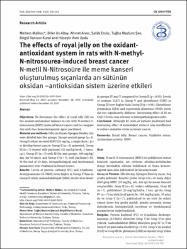The effects of royal jelly on the oxidantantioxidant system in rats with N-methyl- N-nitrosourea-induced breast cancer

Göster/
Erişim
info:eu-repo/semantics/openAccessTarih
2018Yazar
Malkoç, MeltemAltay, Diler Us
Alver, Ahmet
Ersöz, Şafak
Şen, Tuğba Mazlum
Kural, Birgül Vanizor
Uydu, Hüseyin Avni
Üst veri
Tüm öğe kaydını gösterKünye
Malkoç, M., Altay, D.U., Alver, A., Ersöz, Ş., Şen, T.M., Vanizör, B., Uydu, H.A. ve diğerleri. (2018). The effects of royal jelly on the oxidantantioxidant system in rats with N-methyl- N-nitrosourea-induced breast cancer. Türk Biyokimya Dergisi, 43(29, 176-183.Özet
Objectives: To determine the effect of royal jelly (RJ) on the oxidant-antioxidant balance in rats with N-methyl-Nnitrosourea (MNU) induced breast cancer and to compare this with the chemotherapeutic agent paclitaxel. Material and methods: Fifty-six female Sprague Dawley rats were divided into five groups. Except control group (n = 8, Group I) others received MNU (50 mg/kg, a single dose, i.p.) to develop breast cancer: Group II (n = 8) untreated, Group III (n = 7) treated with paclitaxel (15 mg/kg/week, 3 times, i.p.), Group IV (n = 7) with RJ (by oral gavage, 100 mg/kg/ day, for 30 days), and Group V (n = 7), with paclitaxel + RJ. At the end of 30 days, histopathological and biochemical parameters were evaluated in breast tissues. Results: Levels of protein carbonyl (PC) and 8-hydroxydeoxyguanosine (8-OHdG) were higher in Group V than in Group II while malondialdehyde (MDA) levels were lower in groups IV and V compared to Group II (p < 0.05). Levels of catalase (CAT) in Group V and glutathione (GSH) in Group III were higher than Group II (p < 0.05). Glutathione peroxidase (GPx) and superoxide dismutase (SOD) levels did not significantly different. Decreasing effect of RJ on CA15-3 levels was relevant to histopathological results. Conclusion: Although RJ (with or without paclitaxel) had increasing effect of antioxidant status it was insufficient to reduce oxidative stress in breast cancer. Amaç: N-metil-N-nitrosourea (MNU) ile indüklenen meme kanserli sıçanlarda, arı sütünün oksidan-antioksidan denge üzerindeki etkisini belirlemek ve bunu kemoterapötik ajan olan paklitaksel ile karşılaştırmak. Gereç ve Yöntem: Elli altı dişi Sprague Dawley sıçan, beş gruba bölündü. Kontrol grubu Grup I (n = 8) hariç diğer dört grup MNU (50 mg/kg, tek, doz ip) ile meme kanseri oluşturuldu. Grup II (n = 8), tedavi edilmemiş, Grup III (n = 7), paklitaksel (15 mg/kg/hafta, 3 kez, ip) ile; Grup IV (n = 7) arı sütü (oral gavaj ile, 100 mg/kg/gün, 30 gün) ile ve Grup V (n = 7), paklitaksel ve arı sütü ile tedavi olmak üzere beş gruba ayrıldı. günün sonunda, meme dokularında histopatolojik inceleme ve biyokimyasal parametreler değerlendirildi. Bulgular: Protein karbonil (PC) ve 8-hidroksi deoksiguanozinin (8-OHdG) düzeyleri Grup V‘de Grup II‘ye göre yüksek, malondialdehit (MDA) düzeyleri grup IV ve V’de Grup II‘ye göre daha düşüktü (p < 0.05). Grup V‘de katalaz (CAT) ve Grup III’de glutatyon (GSH) seviyeleri Grup II’den daha yüksekti (p < 0.05). Glutatyon peroksidaz (GPx) ve süperoksit dismutaz (SOD) düzeyleri arasında anlamlı farklılık yoktu. Arı sütünün CA15-3 düzeyleri üzerine azaltıcı etkisi, histopatolojik sonuçlar ile uyumlu idi. Sonuç: Meme kanserinde arı sütü (paklitaksel ile veya paklitakselsiz) antioksidan durumu arttırıcı yönde etki göstermesine rağmen oksidatif stresi azaltmada yetersizdi.
Kaynak
Türk Biyokimya DergisiCilt
43Sayı
2Bağlantı
https://doi.org/10.1515/tjb-2017-0140https://app.trdizin.gov.tr/makale/TXpBNU1qVXlNZz09
https://hdl.handle.net/11436/5785

















